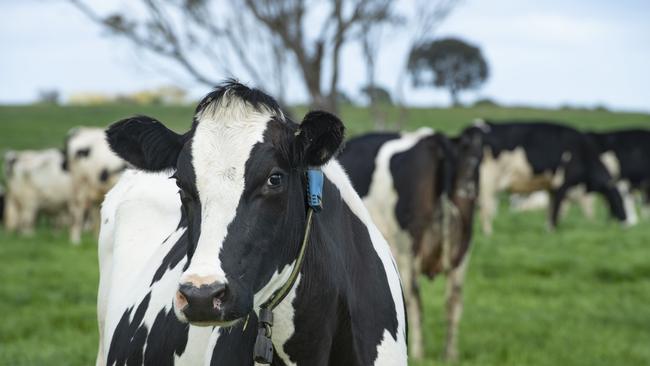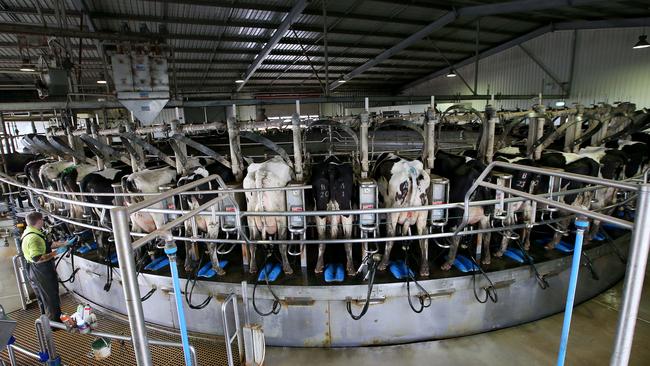Who are Australia’s biggest dairy farmers: the major players
Corporate dairies were on the march in Australia during the 2010s — but change is afoot. Meet the nation’s biggest dairy players.
Corporate dairies are under increasing strain due to labour shortages across Australian agriculture.
Australian Dairy Farmers president Rick Gladigau said while corporate dairy operations expanded throughout the 2010s, the coronavirus era has not been kind to the large-scale milking operation.
“The shortage of labour is a real handbrake on corporate dairies,” he said. “Not just the corporates but mid-size operations too. There comes a certain pint, depending on the number of cows, the age of the farmer, other factors, when you need to hire an extra person or two or three or whatever.
“Corporate dairies don’t just employ one or two, but several, and the labour shortages mean that’s a really expensive exercise, if you can get staff at all.”
Labour shortages may have arrested the march of the corporate model across the nation’s 10 dairy regions but that doesn’t mean there aren’t some big players pumping it out at the farmgate.
Aurora Dairies owns and operates more than 16,000 hectares across 33 farms across all three of Victoria’s dairy regions as well as southeast South Australia. Backed by Canada’s PSP Investments — the biggest investor in Australian farmland with more than $5 billion in assets — Aurora was was established in February 2019 with the purchase of Warakirri Dairies and now runs almost 24,000 cows producing 179 million litres of milk annually.
Its biggest operation is in Gippsland comprising 11,450 cows producing 73 million litres of milk from 20 farms totalling 6200 hectares. It’s second-biggest production footprint is in South Australia’s South East where it runs 6050 cows producing 56 million litres of milk from nine farms and 3350 hectares.
It also has operations in southwest Victoria (3800 cows producing 28 million litres of milk from 2600 hectares), Victoria’s Western District (2000 cows producing 17 million litres of milk from 1060 hectares) and northern Victoria (640 cows producing five million litres of milk from 1010 hectares).

With a swag of acquistions in recent years — including from Beston Global Food Company, Gippsland dairy institution Gray Wigg and Ace Dairy Holdings — Aurora is arguably Australia’s largest corporate dairy operation. Previously, that title was held Van Dairy Limited, a controversial name in the sector that dominates northwest Tasmania.
Employing more than 100 locals in the Smithton region, the historic Woolnorth property used to be a big name in wool but shifted across to dairy under New Zealand ownership in the 1990s.
In 2016, the Foreign Investment Review Board approved the application of Chinese-owned Moon Lake Investments to buy what was then known as Van Diemen’s Land Company.
At the time of the 2016 sale, VDL was Australia’s largest dairy operation, with 18,000 cattle spread over 7000 hectares.
Last year, Melbourne investment company Prime Value purchased 11 of the 25 dairy farms from Van Dairy an estimated $62 million.
In central-west NSW, another big player is nipping at the heels of VDL’s title as the nation’s biggest dairy.
In 2015, two of Australia’s biggest dairy operators formed a consortium backed by Chinese investment.
Moxey Farms entered into an agreement with Leppington Pastoral Company, which forms part of the Australian Fresh Milk Holdings consortium.
Located in the Lachlan Valley, the Moxey land portfolio covers an area of 2700 hectares, with 3700 cattle producing 50 million litres of milk per year.

Victoria has fewer corporate farms compared to other states but foreign investors have seized the potential in recent years.
Dutch-operated Ace Holdings have been operational in mid-Gippsland with Whites farm at Heyfield covering 314 hectares as well as two Maffra farms - Donahoes with 289 hectares and Hill Farm boasting 427 hectares.
Australian Fresh Milk Holdings (AFMH) — which has been a partnership between Chinese agriculture group New Hope, the Perich Group, the Moxey family and ASX-listed Freedom Foods — has two sizeable footprints in Victoria.
Freedom Foods is now known as Noumi Limited – with the renaming required following the sale of the Freedom Foods business to Arnott’s in 2020.
Noumi has since sold its stake in AFMH, announced to the ASX earlier this year, and AFMH is now a joint venture between New Hope and the Perich Group.
A big player in the Western District is Midfield Meats boss Colin McKenna.
The McKenna family owns more than 7000 hectares across eight properties in southwest Victoria as well as the Mt Gambier region, although it is split between his beef enterprise and his dairy interests.
With Van Dairy its most high-profile example, Tasmania has the greatest number of corporate dairy farms.
More than a quarter of dairy farms on the Apple Isle are in the top category of more than 700 cattle, according to Dairy Australia data.
However, that trend is down from 33 per cent of all Tasmanian dairy operations over 700 head in the 2019-20 financial year.





